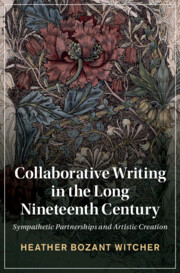17 results
Chapter 2 - “O You Pretty Pecksie!”
-
- Book:
- Collaborative Writing in the Long Nineteenth Century
- Published online:
- 12 March 2022
- Print publication:
- 17 March 2022, pp 31-63
-
- Chapter
- Export citation
Notes
-
- Book:
- Collaborative Writing in the Long Nineteenth Century
- Published online:
- 12 March 2022
- Print publication:
- 17 March 2022, pp 210-236
-
- Chapter
- Export citation
Copyright page
-
- Book:
- Collaborative Writing in the Long Nineteenth Century
- Published online:
- 12 March 2022
- Print publication:
- 17 March 2022, pp iv-iv
-
- Chapter
- Export citation
Introduction
-
- Book:
- Collaborative Writing in the Long Nineteenth Century
- Published online:
- 12 March 2022
- Print publication:
- 17 March 2022, pp 1-12
-
- Chapter
- Export citation
Chapter 6 - Towards Empathy
-
- Book:
- Collaborative Writing in the Long Nineteenth Century
- Published online:
- 12 March 2022
- Print publication:
- 17 March 2022, pp 181-205
-
- Chapter
- Export citation
Chapter 3 - Written–Visual Aesthetics
-
- Book:
- Collaborative Writing in the Long Nineteenth Century
- Published online:
- 12 March 2022
- Print publication:
- 17 March 2022, pp 64-94
-
- Chapter
- Export citation
Chapter 1 - Adam Smith’s Liberal Sympathy
-
- Book:
- Collaborative Writing in the Long Nineteenth Century
- Published online:
- 12 March 2022
- Print publication:
- 17 March 2022, pp 13-30
-
- Chapter
- Export citation
Acknowledgments
-
- Book:
- Collaborative Writing in the Long Nineteenth Century
- Published online:
- 12 March 2022
- Print publication:
- 17 March 2022, pp x-x
-
- Chapter
- Export citation
Chapter 4 - Typographical Adventures
-
- Book:
- Collaborative Writing in the Long Nineteenth Century
- Published online:
- 12 March 2022
- Print publication:
- 17 March 2022, pp 95-143
-
- Chapter
- Export citation
Index
-
- Book:
- Collaborative Writing in the Long Nineteenth Century
- Published online:
- 12 March 2022
- Print publication:
- 17 March 2022, pp 250-258
-
- Chapter
- Export citation
Chapter 5 - Sim and Puss
-
- Book:
- Collaborative Writing in the Long Nineteenth Century
- Published online:
- 12 March 2022
- Print publication:
- 17 March 2022, pp 144-180
-
- Chapter
- Export citation
Dedication
-
- Book:
- Collaborative Writing in the Long Nineteenth Century
- Published online:
- 12 March 2022
- Print publication:
- 17 March 2022, pp v-vi
-
- Chapter
- Export citation
Figures
-
- Book:
- Collaborative Writing in the Long Nineteenth Century
- Published online:
- 12 March 2022
- Print publication:
- 17 March 2022, pp viii-ix
-
- Chapter
- Export citation
Conclusion
-
- Book:
- Collaborative Writing in the Long Nineteenth Century
- Published online:
- 12 March 2022
- Print publication:
- 17 March 2022, pp 206-209
-
- Chapter
- Export citation
Contents
-
- Book:
- Collaborative Writing in the Long Nineteenth Century
- Published online:
- 12 March 2022
- Print publication:
- 17 March 2022, pp vii-vii
-
- Chapter
- Export citation
Bibliography
-
- Book:
- Collaborative Writing in the Long Nineteenth Century
- Published online:
- 12 March 2022
- Print publication:
- 17 March 2022, pp 237-249
-
- Chapter
- Export citation

Collaborative Writing in the Long Nineteenth Century
- Sympathetic Partnerships and Artistic Creation
-
- Published online:
- 12 March 2022
- Print publication:
- 17 March 2022



